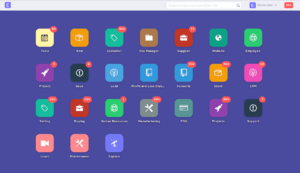ERPNext
 | |
 Desk of ERPNext version 7 | |
| Original author(s) | Rushabh Mehta |
|---|---|
| Developer(s) | Frappé Technologies Pvt. Ltd. and Community |
| Initial release | 2008 |
| Stable release |
10.0.7
/ 9 January 2018[1] |
| Written in | Python and JavaScript |
| Type | ERP, CRM, Accounting, Human resource management, Retail, Healthcare, Education |
| License | GNU GPLv3 |
| Website |
erpnext |
ERPNext is a free and open-source integrated Enterprise Resource Planning (ERP) software developed by Frappé Technologies Pvt. Ltd. and is built on MariaDB database system using a Python based server-side framework. [2]
ERPNext is a generic ERP software used by manufacturers, distributors and services companies. It includes modules like accounting, CRM, sales, purchasing, website + e-commerce, point of sale, manufacturing, warehouse, project management, inventory and services. Also, it has domain specific modules like schools, healthcare, agriculture and non-profit.[3]
ERPNext is an alternative to NetSuite and QAD, and similar in function to Odoo (formerly OpenERP), Tryton and Openbravo. ERPNext was included in the ERP FrontRunners List by Gartner as a Pacesetters. [4]
Industry solutions
ERPNext contains these modules:
- Accounting
- Asset management
- Customer relationship management (CRM)
- Human resource management (HRM)
- Manufacturing
- Point of sale (POS)
- Project management
- Purchasing
- Sales management
- Warehouse management system
- Student Information system
- Hospital Information system
- Agriculture Management
- Nonprofit Organization
Software license
ERPNext is released under the GNU GPLv3 license. Consequently, ERPNext does not require license fees as opposed to proprietary ERP vendors. In addition, as long as the terms of the licenses are adhered to, modification of the program is possible. [5]
Architecture
ERPNext has a Model-View-Controller architecture with metadata modeling tools that add flexibility for users to adapt the software to unique purposes without the need for programming. Some attributes of the architecture are:
- All objects in the ERP are DocTypes (not to be confused with HTML DocTypes) and the Views are generated directly in the browser.
- Client interacts with the server via JSON data objects on a Representational state transfer (RESTful) supporting server.
- There is ability to plug-in (event driven) code on the client and server side.
The underlying web app framework is called "Frappé" [6] and is maintained as a separate open source project. Frappé started as a web based metadata framework inspired from Protégé[7] though it has evolved differently.
This architecture allows rapid application development (RAD).
Source code and documentation
The source code of ERPNext is hosted on GitHub,[8] using the Git revision control system, and the contributions are also handled using GitHub.
A complete user manual is available at the project website.[9]
ERPNext Foundation
ERPNext Open Source Software Foundation is a non-for-profit organization. The goal of the ERPNext Foundation is to provide a platform for the ERPNext community to come together and build assets to enhance ERPNext around the world. [10] It has various membership plans and has members across the world. Foundation also organises various events like conference and code sprints.
Innovations
The primary innovation of ERPNext has been in the metadata modeling architecture which provides for flexible use of the application without custom programming. [11]
The user interface incorporates usability enhancements designed to improve ease of use and user productivity.

Software as a service
ERPNext is available as a Software as a service in addition to user-hosting.[12]
Reporting
ERPNext provides an embedded reporting system with office suite integration. Report customization is available within ERPNext. [13]
Release History
| Version | Release Date/Month | Significant changes | Software license |
|---|---|---|---|
| 1.0 | June 2010 | First release. ERPNext source code was published on Google Code. | GNU GPL |
| 2.0 | July 2012 | GNU GPL | |
| 3.0 | April 2013 | GNU GPL | |
| 4.0 | February 2014 | Introduced app architecture in Frappe Framework. | GNU GPL |
| 5.0 | 19 May, 2015[14] | Improved UI, Item Variants, Print Format Builder, Sharing, Starring, Document Timelines, Multi-Currency accounting, Party model | GNU GPL |
| 6.0 | 2 September, 2015[15] | ERPNext Schools, Calendar View for transactions, Doctype exports | GNU GPL |
| 7.0 | 22 July, 2016[16] | Online/Offline POS, Asset Depreciation, Payment Entry, Timesheets, Dashboards, Editable grid, Quick Entry view, Smarter Lists | GNU GPL |
| 8.0 | 30 March, 2017[17] | Global Search, Kanban View, Document Versioning, Delete and Restore, Email Inbox, Employee Loan, Enhanced POS, Multiple UOMs in Selling, Accrual system in Payroll, Custom Permissions, Customer Feedback, School Assessment Module [18] | GNU GPL |
| 9.0 | 26 September , 2017[19] | Healthcare Domain, Subscription, School Fees Management, New Setup Wizard | GNU GPL |
| 10.0 | 29 December, 2017[20] | Agriculture Domain, Non-profit Domain, Data Import upgrades, Employee Advance, Item Variant Enhancements | GNU GPL |
| 11.0 | 2018 (ETA) | Multi-company consolidated financial statement, Payroll per Tax Declaration, Employee On-boarding and Off-boarding, Finance Book, CWIP Accounting, Staffing Plan, Inter-company Journal Entry, Exchange Rate Revaluation, Leave Policy, Conditional Workflows, Payroll and Accounting Period, Serialised Assets, Tax Withholding, Shift Plan, Budgeting in Material Request | GNU GPL |
References
- ↑ ERPNext releases page
- ↑ opensource.com, ERPNext among Top 9 open source ERP systems to consider
- ↑ Capterra, Top 8 free and open source ERP
- ↑ Software Advice, FrontRunners® for Enterprise Resource Planning, October 2017
- ↑ ERPNext license
- ↑ Frappé Framework
- ↑ Protege
- ↑ ERPNext repository
- ↑ ERPNext User Manual
- ↑ "ERPNext Foundation Profile" on Zaubacorp
- ↑ "Customize ERPNext" chapter from the manual
- ↑ https://erpnext.com/pricing
- ↑ "Making custom reports in ERPNext" article from the manual
- ↑ "ERPNext Version 5 release log on Github
- ↑ "ERPNext Version 6 release log on Github
- ↑ "ERPNext Version 7 release log on Github
- ↑ "ERPNext Version 8 release log on Github
- ↑ "ERPNext Version 8 features
- ↑ "ERPNext Version 9 release log on Github
- ↑ "ERPNext Version 10 release log on Github